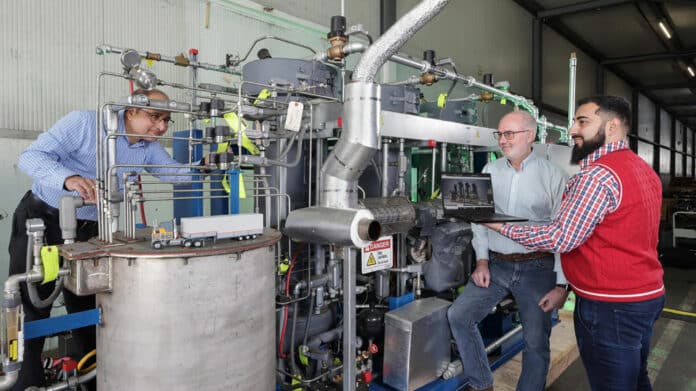Climate change is one of the major challenges of our time, and we need to do more than cut our greenhouse gas emissions and transition to renewable energy to reach Net-Zero emissions by 2050. We’ll also need to remove billions of tons of CO2 from the atmosphere.
A major contributor to these emissions is the freight industry, which accounts for about 10% of our global carbon footprint and poses a huge challenge in terms of decarbonization.
According to the Swiss Federal Statistical Office, trucks carrying goods across Switzerland release over a million tons of CO2 yearly. Though electric trucks are on the rise, they are still not the norm, with just 600 electric trucks weighing at least 16 metric tons registered in the EU in the first quarter of 2023, compared to 86,455 combustion-engine ones.
EPFL spin-off Qaptis aims to reduce the carbon footprint of these conventional freight trucks with its new decarbonization system, which traps the CO2 coming out of the exhaust pipe and stores it in a liquid state. This innovative system has the potential to cut freight trucks’ carbon emissions by up to 90%.
The company has installed a prototype of its technology at a local freight carrier based in Tolochenaz to test its performance and feasibility under real-world conditions. It aims to commercialize its CO2 capture system for heavy-duty vehicles by 2026.
The system’s core technology was developed at EPFL’s Industrial Process and Energy Systems Engineering Laboratory of the Ecole Polytechnique Fédérale de Lausanne (EPFL). Their innovation is based on converting CO2 from a gas to a liquid state with minimal external energy input, creating a positive feedback loop.
The Qaptis system is designed to be installed on existing trucks. Once the CO2 is captured from the exhaust pipe, it undergoes cooling and separation from other gases, such as nitrogen and oxygen, using adsorbent powder. The company eventually plans to use an organometallic powder, which is not currently being produced on an industrial level, that will further improve its process.
After the adsorbent reaches saturation, it is heated with the heat generated from the combustion engine. This heats up and releases the CO2, which is then compressed into a liquid state by high-speed turbochargers to reduce its volume. The liquid CO2 will be stored in a tank behind the cab and can be drained when the truck returns to its freight terminal.
“We’ve finally completed the first step, which was transferring our core technology from the lab to industry,” says Théodore Caby, Qaptis co-founder and COO. “Now we’ll focus on developing a device that can be installed directly in trucks.”
The firm initially plans to target local freight carriers that want to reduce their environmental impact. Later on, they will develop a recovery system that will allow drivers to empty their CO2 tanks at gas stations so that its technology can be employed more broadly.
Qaptis recently raised CHF 1.3 million from business angels and venture capital funds, which will help the startup scale up its operations and optimize its product. Despite being somewhat cumbersome, the prototype can be hooked up with standard connections and can run under normal conditions.
It was initially tested at a US firm with which Qaptis has long-standing ties but was recently transferred to Tolochenaz for further optimization work. However, it may still take a few more months before the system is miniaturized enough to be installed on vehicles.
“Our goal is to create a breakthrough device that’s modular and compatible with different kinds of trucks,” Caby explains. “So we’ll need to go through several iterations outside the lab in order to make it ready for everyday use.”
